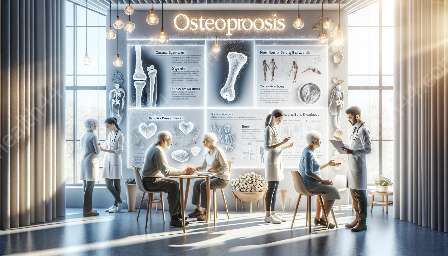Osteoporosis is a condition characterized by reduced bone density and an increased risk of fractures. Fracture risk assessment plays a crucial role in diagnosing, managing, and preventing osteoporosis, as well as other health conditions. This comprehensive topic cluster aims to provide a deeper understanding of osteoporosis, fracture risk assessment, and their impact on overall health.
Understanding Osteoporosis
Osteoporosis is a bone disease that occurs when the body loses too much bone, makes too little bone, or both. This leads to weakened bones that are more susceptible to fractures, especially in the hip, spine, and wrist. The condition often progresses silently without noticeable symptoms until a fracture occurs. Osteoporosis is a significant public health concern, particularly among older adults and postmenopausal women.
Impact on Fracture Risk
Osteoporosis significantly increases the risk of fractures, which can have serious consequences, including disability and reduced quality of life. Fractures related to osteoporosis commonly occur in the hip, spine, and wrist, and can lead to prolonged pain, loss of mobility, and increased mortality risk, especially in older adults. Understanding and managing fracture risk associated with osteoporosis is essential for preserving bone health and overall well-being.
Fracture Risk Assessment
Fracture risk assessment involves evaluating an individual's likelihood of experiencing a fracture, often utilizing various diagnostic tools and assessments. These assessments consider factors such as bone density, age, sex, family history, lifestyle, and previous fracture history. Accurately assessing fracture risk enables healthcare providers to identify individuals at high risk and implement appropriate preventive measures and treatments.
Link to Health Conditions
Osteoporosis and fracture risk assessment are closely linked to various health conditions, including endocrine disorders, autoimmune diseases, certain medications, and nutritional deficiencies. Additionally, the impact of osteoporosis and fractures extends beyond bone health, influencing overall physical and mental well-being. Understanding the intersection between osteoporosis, fracture risk, and other health conditions is crucial for comprehensive healthcare management.
Managing Osteoporosis and Fracture Risk
Managing osteoporosis and fracture risk involves a multidisciplinary approach, encompassing lifestyle modifications, medications, and preventive measures. Lifestyle interventions may include exercise, adequate calcium and vitamin D intake, and fall prevention strategies. Medical treatments, such as bisphosphonates and other bone-strengthening medications, are often prescribed to reduce fracture risk. Additionally, patient education, regular monitoring, and timely interventions play pivotal roles in managing these health conditions.
Prevention and Early Intervention
Preventing osteoporosis and fractures through early intervention and proactive management is essential for promoting bone health. This encompasses raising awareness about risk factors, promoting bone-preserving behaviors, and ensuring timely screenings and risk assessments. Prevention strategies also focus on addressing modifiable risk factors, promoting healthy aging, and implementing personalized treatment plans to reduce the burden of osteoporosis-related fractures.
Conclusion
Osteoporosis and fracture risk assessment are interconnected elements that significantly impact individuals' health and quality of life. By understanding the relationship between osteoporosis, fracture risk, and overall health, individuals and healthcare providers can work together to effectively manage these conditions, minimize fracture risk, and promote optimal bone health.


